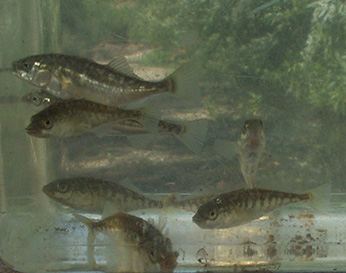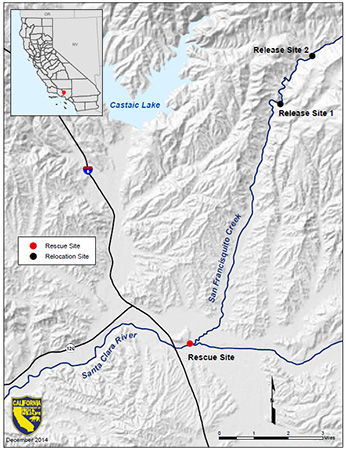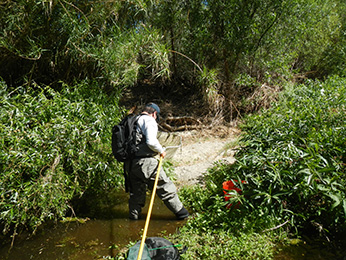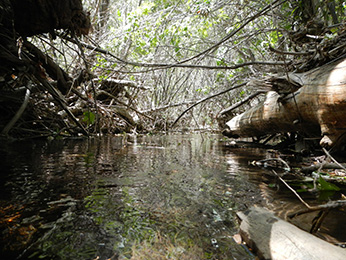Update (June 2015)
 Rainbow trout.
Rainbow trout.
 (click/tap to enlarge)
(click/tap to enlarge)
On April 29 and May 27 of 2015, CDFW staff surveyed one release site on San Francisquito Creek where the majority of rescued Unarmored Three Spine Stickleback (UTS) were released (see full story below). After surveying all watered portions of the creek at and below where fish were released in 2014, no UTS were observed. Due to heavy debris and the complexity of the creek, these sections of San Francisquito Creek are difficult to completely survey. Additionally, the amount of fish released compared to the length of water survey, may make detection of UTS difficult unless breeding occurs over several seasons.
CDFW staff will continue to survey San Francisquito Creek in the coming years to determine if the translocation of UTS was beneficial to the continuation of this unique population.
Species Distribution
The Unarmored Three Spine Stickleback (UTS), Gasterosteus aculeatus williamsoni is a state and federally listed endangered species and a State of California Fully Protected Species. UTS have a very limited distribution, with the southern California population represented in only three drainages; Upper Santa Clara River (extremely limited), Bouquet Creek (extremely limited) and Soledad Canyon Creek (possibly extirpated). These declining populations have driven a joint UTS Recovery Plan between the US Fish and Wildlife Service (USFWS) and the California Department of Fish and Wildlife (CDFW) drafted in 2012.
Necessity of Rescue
Prior to 2014’s extreme drought conditions, the UTS Recovery Plan described increasing the number of viable UTS populations here in southern California by trans-locating UTS from a healthy, Santa Clara River population, to quality habitat identified in San Francisquito Creek. Since the San Francisquito population was determined to be extirpated in 2005, replenishing this population with transplanted UTS from the Santa Clara River became a top priority for CDFW. But serious drought conditions and changes in the environment diminished wetted habitat in the Santa Clara River, putting the source population at risk. Reduced water and UTS occupied pools observed by CDFW in the early spring of 2014 elevated the proposed translocation to and emergency fish rescue.
Relocation Site
Two release sites were identified on San Francisquito Creek. Easy access entry points to the release sites prior to the rescue effort were also identified. Both sites had good UTS habitat with reliable year round flows (perennial), but the site 1 contained higher quality habitat and more water.
Rescue Methods
On April 30, 2014, agency staff and volunteers began rescuing UTS in dwindling pools using dip nets and buckets (Figure 1). Prior to each rescue effort, water from the San Francisquito Creek release site was collected and stored in transport coolers. Once fish were captured, they were gradually acclimated to the release water prior to transport.
 Figure 1.
Figure 1.
Fish Survival
A total of 569 UTS were successfully transported from the source population to the release areas (Figure 2) in San Fracisquito Creek. Site 1 received a total of 406 fish on 30, May 23, and August 8. Site 2 received 163 fish on May 1. Six mortalities occurred during the May 1 transport. This four day rescue effort resulted in the successful transfer of 569 UTS from the source population to San Francisquito. Post release monitoring of the new population will commence in the spring of 2015. This will be a joint effort between all three agencies.
 Figure 2.
Figure 2.
Data
| Date |
Site 1 |
Site 2 |
Mortalities |
Total |
| April 30, 2014 |
175 |
0 |
0 |
175 |
| May 1, 2014 |
0 |
169 |
6 |
163 |
| May 23, 2014 |
229 |
0 |
0 |
229 |
| August 8, 2014 |
2 |
0 |
0 |
2 |
| Total |
406 |
169 |
6 |
569 |
Future Santa Clara River
Extreme drought conditions exacerbated the status of the dwindling populations in Santa Clara River. Partners will continue monitoring pools for UTS in 2015.
Collaborating Agencies
California Department of Fish and Wildlife, U.S. Fish and Wildlife Service, and U.S. Forest Service
Project Permitting
Interagency Fish Rescue Policy (CDFW/NMFS/USFWS). Fish rescue by CDFW is exempt under CEQA.
CDFW Region 5